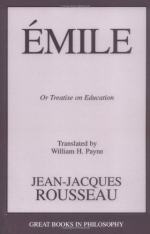One cannot learn to estimate the extent and size of bodies without at the same time learning to know and even to copy their shape; for at bottom this copying depends entirely on the laws of perspective, and one cannot estimate distance without some feeling for these laws. All children in the course of their endless imitation try to draw; and I would have Emile cultivate this art; not so much for art’s sake, as to give him exactness of eye and flexibility of hand. Generally speaking, it matters little whether he is acquainted with this or that occupation, provided he gains clearness of sense—perception and the good bodily habits which belong to the exercise in question. So I shall take good care not to provide him with a drawing master, who would only set him to copy copies and draw from drawings. Nature should be his only teacher, and things his only models. He should have the real thing before his eyes, not its copy on paper. Let him draw a house from a house, a tree from a tree, a man from a man; so that he may train himself to observe objects and their appearance accurately and not to take false and conventional copies for truth. I would even train him to draw only from objects actually before him and not from memory, so that, by repeated observation, their exact form may be impressed on his imagination, for fear lest he should substitute absurd and fantastic forms for the real truth of things, and lose his sense of proportion and his taste for the beauties of nature.
Of course I know that in this way he will make any number of daubs before he produces anything recognisable, that it will be long before he attains to the graceful outline and light touch of the draughtsman; perhaps he will never have an eye for picturesque effect or a good taste in drawing. On the other hand, he will certainly get a truer eye, a surer hand, a knowledge of the real relations of form and size between animals, plants, and natural objects, together with a quicker sense of the effects of perspective. That is just what I wanted, and my purpose is rather that he should know things than copy them. I would rather he showed me a plant of acanthus even if he drew a capital with less accuracy.




